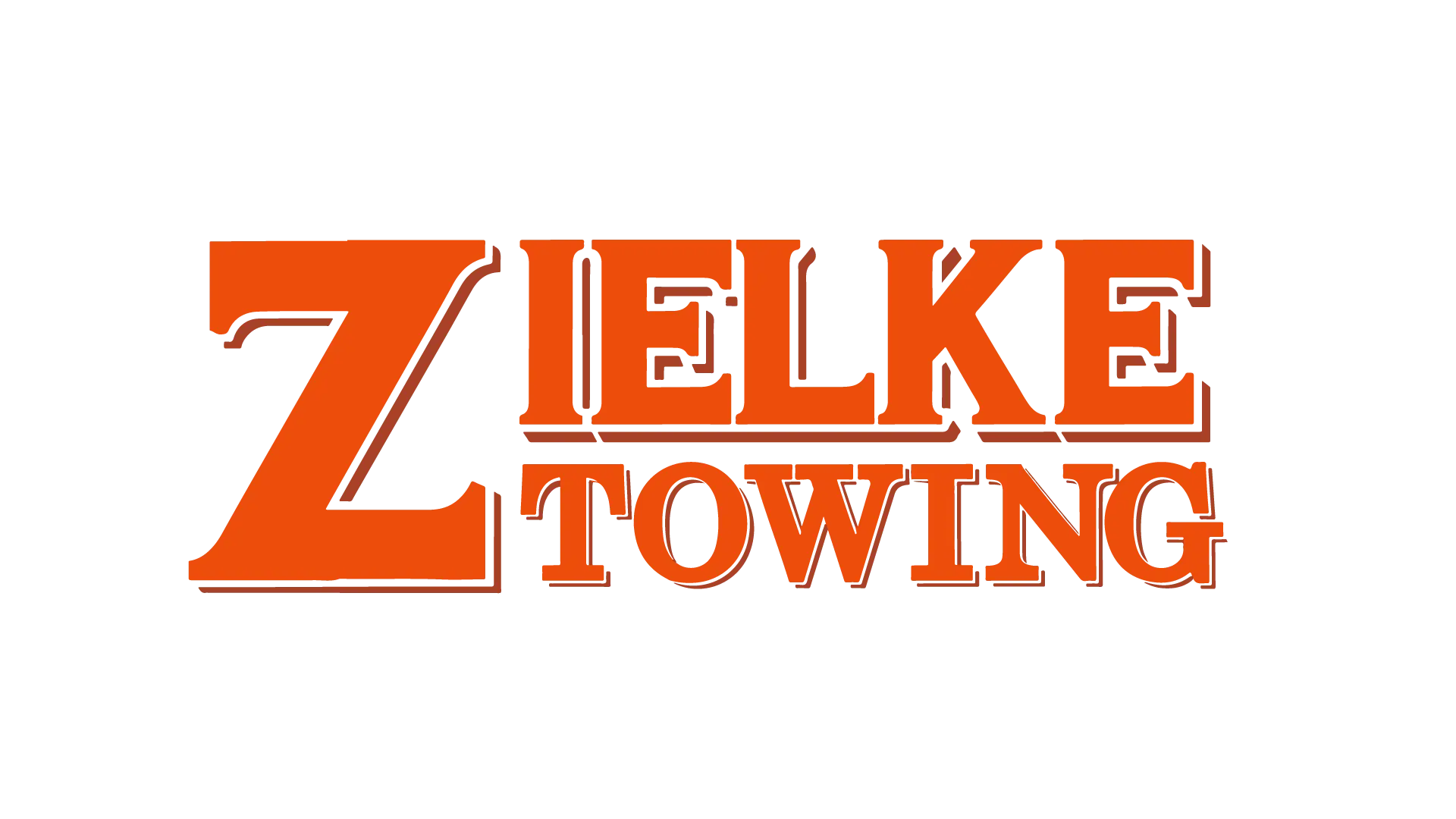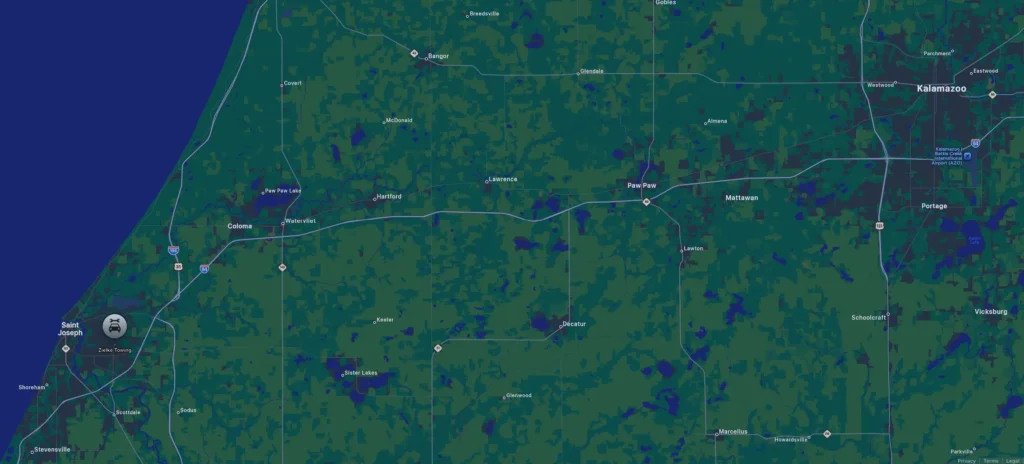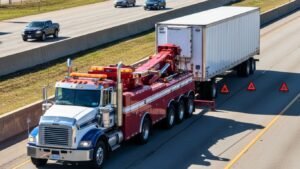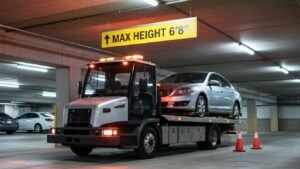Every Trucker’s Big Question
You’re hauling a loaded trailer down the interstate when suddenly your truck loses power. The dash lights up, alarms sound, and you know a breakdown is coming. Panic sets in: “Can the entire rig—truck plus trailer—be towed together, or do I need to uncouple?”
This guide answers that question with expert clarity. We’ll walk through immediate safety steps, towing options, regulatory requirements, and the decision-making process for drivers and fleet managers. Drawing on industry best practices, experienced driver insights, and fleet manager protocols, this handbook ensures you know exactly what to do if your tractor-trailer needs a tow.
Immediate Safety Actions (First 5 Minutes)
Get to Safety Fast
- Pull Over Safely: Move your rig to the shoulder, rest area, or designated emergency turnout. Avoid soft ground where a heavy trailer could sink.
- Hazard Lights: Activate flashers immediately so other drivers see your stopped vehicle.
- Triangles and Reflectors: Place three reflective triangles—at 10 feet, 100 feet, and 200 feet behind the trailer in the same lane. This is a DOT requirement.
- Exit Safely: Leave the cab on the side away from traffic and stand clear of moving vehicles.
Secure Truck and Trailer
- Parking Brake & Wheel Chocks: Set brakes on both tractor and trailer. Place chocks if on a slope.
- Inspect Cargo: Confirm the load hasn’t shifted. A shifting trailer load increases towing risk.
- Trailer Visibility: Keep lights on the trailer illuminated if possible for visibility.
Alert Traffic and Authorities
- Notify Dispatch: Provide rig location, highway, mile marker, and cargo type.
- DOT Emergency Notification: Required if hazardous materials are onboard.
- Call 911 if Necessary: If your rig poses a hazard to traffic or is in a dangerous spot. Otherwise, arrange professional roadside assistance.
Breakdown Assessment and Documentation

- Visual Check: Inspect engine bay, hoses, belts, tires, and trailer couplings.
- Dashboard Warnings: Note engine, brake, ABS, or transmission lights.
- Listen & Smell: Identify burning, fluid leaks, or unusual noises.
Photo Documentation Process
Take clear photos of:
- Tractor and trailer position relative to road.
- Any visible mechanical issues.
- Trailer ID numbers, license plates, and mile markers.
Communication with Dispatch
Share:
- Condition of Truck: Engine dead, overheating, blown tire, etc.
- Trailer Load: Type, weight, hazardous vs. non-hazardous.
- ETA Impact: Expected delivery delay.
- Insurance Coordination: Ensure compliance with fleet policy.
Common Breakdown Scenarios and Solutions
Tractor (Truck) Failures
- Overheating: Shut down immediately; continuing risks engine seizure.
- Oil Pressure Loss: Stop and do not restart—tow required.
- Electrical Failure: If lights or engine control fail, tow both tractor and trailer.
Trailer-Specific Issues
- Brake Lockups: Tow operator may need dollies or air system reset.
- Tire Blowouts: Sometimes fixable roadside; otherwise, tow with load intact.
- Coupling/Suspension Damage: Requires separating tractor and trailer.
Combined Rig Breakdowns
- Both Units Disabled: Tow with rotator or wrecker service.
- Jackknife Risks: Secure with professional winching and straightening before tow.
- Hazmat Cargo: Special DOT-certified towing required.
Working with Roadside Assistance and Heavy-Duty Towing
Choosing the Right Service Provider
- Heavy-Duty Tow vs. Standard: Only heavy-duty wreckers and rotators can tow tractor-trailers intact.
- 24/7 Response: Essential for highway breakdowns.
- Insurance Coverage: Verify your plan covers towing with trailers attached.
Preparing for Service Arrival
- Safe Positioning: Ensure tow truck access by straightening tractor and trailer as much as possible.
- Gather Documents: License, registration, bill of lading, and permits.
- Secure Cargo: Lock doors, straps, and seals.
Repair vs. Tow Decision Making
- On-Site Repairs: Tires, hoses, and brake chambers can sometimes be fixed on site.
- Tow Entire Rig: If the truck cannot power the trailer safely, tow together.
- Uncouple When Necessary: For structural trailer damage or excessive weight.
Legal and Regulatory Compliance
DOT Hours of Service Impact
- Breakdowns pause operations but still count toward HOS rest rules.
- ELD entries must show breakdown location and downtime.
- Dispatch must adjust schedules accordingly.
Cargo and Delivery Obligations
- Customer Notifications: Inform shippers immediately of delays.
- Transloading: Arrange cargo transfer if tow is impossible with the trailer.
- Insurance: Protect against liability if perishable or valuable goods are affected.
Interstate and State Regulations
- Cross-State Towing: Some states require special permits for towing full rigs.
- Oversized Loads: Towing loaded trailers may exceed length/weight restrictions.
- Environmental Compliance: Any spill (fuel or cargo) must be reported.
Prevention Strategies and Maintenance
Pre-Trip Inspection Excellence
- Daily Inspections: Check tractor and trailer systems before departure.
- Warning Sign Recognition: Spotting vibration, leaks, or uneven braking early prevents breakdowns.
- Maintenance Schedule: Follow fleet maintenance strictly.
Route Planning for Rigs with Trailers
- Identify Safe Zones: Rest areas and truck stops suitable for rigs.
- Service Provider Coverage: Map heavy-duty tow companies along your route.
- Alternative Routes: Plan detours for emergencies.
Emergency Kit Essentials
- Heavy-duty reflective triangles (3 minimum).
- Portable air hose, brake fuses, spare bulbs.
- Communication gear: CB radio, satellite phone.
- First aid and safety equipment.
Financial and Business Impact Management
Cost Control During Breakdowns
- Tow Costs: Heavy-duty rig tows range $400–$1,200+.
- Avoid Extra Fees: Don’t request unnecessary uncoupling.
- Claims: Keep all receipts for reimbursement.
Minimizing Delivery Delays
- Communicate early with customers.
- Prioritize critical loads.
- Arrange alternate tractors for trailer pickups.
Fleet Management Coordination
- Dispatch backup drivers.
- Reassign cargo among trucks.
- Keep utilization balanced despite breakdown.
Technology and Communication Tools
Mobile Apps and GPS Solutions
- Share rig location and trailer length for tow planning.
- Use apps to find certified heavy-duty providers.
- Get real-time traffic/weather updates.
Electronic Logging and Fleet Management
- Record breakdowns in ELDs.
- Fleet systems can auto-alert dispatch.
- Automated scheduling tools reroute other loads.
Emergency Communication Protocols
- Satellite Backup: Stay connected in dead zones.
- CB Channels: Channel 9 for emergencies.
- Phone Power: Use portable battery packs.
Regional and Seasonal Considerations
Weather Challenges
- Winter: Frozen trailer brakes and black ice hazards.
- Summer: Engine overheating while hauling weight.
- Storms: Tow trucks may be delayed; secure rig until safe.
Geographic Challenges
- Mountain Passes: Requires winching and advanced towing gear.
- Urban Areas: Limited maneuvering space for full rig towing.
- Rural Routes: Fewer heavy-duty tow operators available.
Making Critical Decisions Under Pressure
Rapid Assessment Checklist
- Can the trailer remain coupled safely?
- Is heavy-duty tow access possible?
- Does the load require special handling?
- Will delivery deadlines be impacted?
When to Tow Rig vs. Separate Trailer
- Tow Together: If safe and within tow truck capacity.
- Uncouple: If trailer is damaged, overweight, or creates safety risk.
- Decision Tree: Truck breakdown + trailer intact = tow together. Both damaged = separate.
Conclusion & Expert Recommendations
Your Rig Towing Action Plan
- 0–5 Minutes: Secure rig, hazards, triangles, notify dispatch.
- 5–15 Minutes: Assess condition, document, share with dispatch.
- 15+ Minutes: Decide repair vs. tow vs. uncoupling.
Building Breakdown Resilience
- Invest in preventative maintenance.
- Train drivers on tractor-trailer emergency procedures.
- Partner with heavy-duty tow services near major routes and hubs.
If you’re ever stranded near 1303 M-139, Benton Harbor, MI 49022, United States, local heavy-duty towing providers are equipped to handle full tractor-trailer recovery.
By following this structured approach, you’ll know exactly what to do when your truck and trailer face a breakdown—staying safe, compliant, and on track for business continuity.





